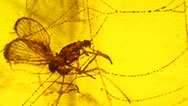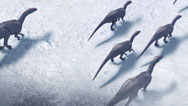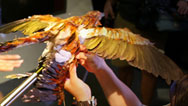Dinosaur Plague
- Posted 07.14.09
- NOVA scienceNOW
(This video is no longer available for streaming.) What killed off the dinosaurs? Over the years, experts have suggested everything from global climate change to a spate of massive volcanic eruptions to the most widely accepted culprit: an asteroid that unleashed global devastation. But as correspondent Chad Cohen reports, some scientists believe the giant reptiles might have been taken down by something almost too tiny to see.
Transcript
Dinosaur Plague
PBS Airdate: July 14, 2009
NEIL DeGRASSE TYSON: Ever since we've known dinosaurs once walked the earth, we've been debating about what could have killed them off. There've been a lot of ideas kicked around over the years, like global climate change caused by shifts in the earth's axis or a series of monster volcanoes. And for the last 25 years, the most popular idea has been that dinosaurs were wiped out by a giant rock from space, an asteroid that created devastation on a global scale.
But as correspondent Chad Cohen reports, not every scientist is ready to blame just the rock. Some believe the giant reptiles might have been taken down by something almost too tiny to see.
CHAD COHEN (Correspondent): At the Poinar residence, in Corvallis, Oregon, the workday starts early. At least, it does for George.
ROBERTA POINAR: He's up with the dawn, he goes down in his socks or his slippers, sneaking, so he won't wake me up.
CHAD COHEN: As he makes his way downstairs, to his homegrown lab in the basement, he's bent on finding things that no one else has even looked for.
ROBERTA POINAR: He gets up in the morning to make discoveries.
GEORGE POINAR: Oh, wow, Roberta come look at this. It's the...
ROBERTA POINAR: He's just like a kid, that everything is new and wonderful.
CHAD COHEN: For decades, George and his wife and colleague, Roberta, have bucked the trends in mainstream science, painting a novel picture of life in the ancient world. Preserved in pieces of amber, they've discovered insects, flowers, even tiny animals, all trapped in time.
If this sounds familiar, it was their work that inspired Jurassic Park, in which scientists use amber to, literally, bring the dinosaurs back to life.
SAM NEILL (As Doctor Alan Grant in Jurassic Park/Film clip): It's a dinosaur!
GEORGE POINAR: The movie depicted a mosquito that had actually been caught in resin, and then fossilized into amber. And that's scientifically correct, because amber preserves things so beautifully.
CHAD COHEN: Scientifically correct, at least, until Jurassic Park scientists discover something no real scientist had ever found before: a 100-million-year-old mosquito trapped in amber, with dino blood in its gut. They use it to re-create the mighty creatures.
GEORGE POINAR: This is a movie, this is a film, this is Hollywood. They can do whatever they want. That'd be neat if we could actually do it.
CHAD COHEN: And to date, only Hollywood can.
But then, in 2001, George received an unusual package by special delivery, a one of a kind piece of amber, containing a bloodsucking insect, a lot like the one in Jurassic Park.
Rather than using this extraordinary specimen to resurrect the dinosaurs, he believes it could help reveal what caused their demise.
Most scientists theorize that dinosaurs died out suddenly, in a fiery explosion caused by an asteroid, but not George. He believes by the time of the impact, most of the dinosaurs had already died.
You ask a scientist these days and they'll say a giant rock struck Earth 65 million years ago, somewhere around the Yucatan, and did in the dinosaurs. But you're not buying that?
GEORGE POINAR: Well, the thing is that most people have kind of jumped on the bandwagon for the asteroid theory, and what we've done is to present a different theory.
CHAD COHEN: Based on what he's found trapped in amber, George believes the mightiest of creatures—the dinosaurs—were brought down by the tiniest of creatures—biting, disease-carrying insects.
His first clue was found in that special delivery.
GEORGE POINAR: We got the specimen, put it under the microscope, saw it's a sandfly. So we went to the next objective, magnified it a little bit and then, "Oh, I see there's some dark substance in the abdomen."
CHAD COHEN: In all his years he'd never seen anything like this. It appeared as if the sandfly's last meal was still trapped inside its tummy. It looked an awful lot like blood. He asked Roberta to take a look.
GEORGE POINAR: When I first showed her that, she said, "Well, you'd better make sure that that's blood."
We've got some more work to do here.
ROBERTA POINAR: Yep, you have your job cut out for you.
CHAD COHEN: The only way to find out was to get a closer look. That meant cutting away the amber around the sandfly. It's very tricky business. In the process he could easily destroy the tiny fossil and maybe lose a finger, too.
After each cut, he polished and carefully examined the specimen.
ROBERTA POINAR: You have to spend hours and hours and days and weeks and months turning the same specimen over.
CHAD COHEN: Searching for the best angle to get a glimpse of what's inside.
ROBERTA POINAR: You're looking through multiple layers of tissue and you have to find that window.
CHAD COHEN: By cutting the amber down to within one millimeter of the sandfly, George found the window he needed to see this: blood cells from what appeared to be a reptile.
The discovery made him think.
GEORGE POINAR: If these sandflies are feeding on reptiles, certainly the dinosaurs would have been included.
CHAD COHEN: While blowing up photographs of the sandfly, using an enlarger about as ancient as his amber, he made another astonishing find.
GEORGE POINAR: Wow, look at that!
CHAD COHEN: This was no blood cell.
GEORGE POINAR: Roberta.
CHAD COHEN: George found a microorganism inside the fly.
ROBERTA POINAR: Oh wow, that's amazing.
CHAD COHEN: But what was it? Consulting with experts around the world, he identified it as a deadly parasite called Leishmania that's still around today, killing thousands of people every year. And it's spread by sandflies.
Over the next few months he found more evidence: ten fossilized insects carrying the same deadly parasite. Then he found this: a midge with malaria and another one carrying the parasite for sleeping sickness, all deadly infectious diseases.
ROBERTA POINAR: How could this be? There was an epidemic going on, a whole epidemic. The dinosaurs were probably pretty sickly.
CHAD COHEN: The Poinars believe their evidence points to widespread disease among the dinosaurs, but if there was, in fact, an epidemic going on, that's challenging to prove. We don't exactly have dinosaur tissue to do autopsies, and bones can only tell us so much.
ROSS MACPHEE (American Museum of Natural History): They suffered, just like we do, from things like osteoarthritis. There's much less evidence of infectious disease; it's not going to leave impressions that paleontologists can find on bone.
CHAD COHEN: They did however leave behind another less-appreciated memento that could yield some clues about the state of their health.
So you're telling me this is fossilized dinosaur poop?
KAREN CHIN: Yes, fossilized feces from dinosaurs. We actually call them coprolites...
CHAD COHEN: Coprolites?
KAREN CHIN: ...which is the scientific word for fossilized feces. Not necessarily dinosaur. But these, this is dinosaur.
CHAD COHEN: This is dinosaur.
Not many coprolites survived the ages, but in Jurassic Park, the fresh stuff was easy to find.
To put this in perspective...a male elephant, the largest land animal alive today, weighs in at about 6.5 tons and he voids, on the average, about 22 pounds, 17 times a day. That's over 300 pounds in 24 hours; not a pretty sight.
Now take that image and exchange it with this, a sauropod, and he's up to 15 times heavier than the elephant. It's hard to imagine how much dung this giant dumped.
KAREN CHIN: When we look at pictures of dinosaurs we often see them tromping through really pristine fields. Actually those fields probably would have been littered with dinosaur dung.
CHAD COHEN: Piles of poop, swarming with insects and, likely, swimming in pathogens. And that's an environment that, today, would potentially cause disease.
KAREN CHIN: Yes, I have no doubt that the dinosaurs did get sick.
CHAD COHEN: While Karen's coprolites don't show evidence of the deadly parasites George and Roberta discovered in ancient amber, she, along with graduate student Justin Tweet, did find this.
KAREN CHIN: You see these lines here? Justin found about 200 of these very distinctive tiny burrows.
CHAD COHEN: Burrows, Karen believes, may have been made by worms. There's a thought: dinosaurs with stomach worms.
GEORGE POINAR: I think the dinosaurs were carrying all kinds of pathogens with them.
NATHAN WOLFE (University of California, Los Angeles): They had parasites, they had bacteria, lots of viruses. Without a doubt, microorganisms impacted the day-to-day lives of dinosaurs.
CHAD COHEN: That's not exactly a surprise; everything carries microorganisms, from worms to bacteria to viruses. We, too, host a multitude of guests that use us as a source of food and shelter. Most of the time, we peacefully co-exist, but as we all know, microorganisms can sometimes make us sick.
But could they have caused the downfall of hundreds of species of dinosaurs?
NATHAN WOLFE: It's unclear that we've seen the ability of any microorganism—viral, bacterial or otherwise—to have that level of impact.
ROSS MacPHEE: Until recently nobody was thinking that extinction could be caused merely by disease. That's changing.
CHAD COHEN: In fact, some scientists think there's a perfect example of it taking place today, right before our eyes.
Zoologist Andrew Blaustein, of Oregon State University, took me to a tiny pond, so I could see for myself.
ANDREW BLAUSTEIN (Oregon State University): The scale is unbelievable. It's worldwide, and it's similar to the dinosaur extinctions, except it's happening in modern time.
CHAD COHEN: And this time, it's happening to amphibians. Frogs, toads and salamanders are disappearing at an alarming rate. Since the 1970s, over 100 species have gone extinct.
ANDREW BLAUSTEIN: They are in trouble, big trouble.
CHAD COHEN: And one of reasons is the spread of infectious diseases.
ANDREW BLAUSTEIN: Here's the perfect example. Here you see a little frog—this is a tree frog—and these things are getting infected by all kinds of diseases. In the same body of water where I just picked this guy up, there are these snails. That snail carries a parasite that infects that frog.
CHAD COHEN: Andrew and I were often interrupted by another example.
ANDREW BLAUSTEIN: You hear that bullfrog out there? This is not a native species to the western United States, and it carries a deadly fungus known as the chytrid fungus, and the native species right here in this pond and lake can get that fungus. As a matter of fact, every single bullfrog that we find in this area has been infected, but they don't get sick, they just carry it.
CHAD COHEN: The bullfrog, like the snail, is a new resident in the pond. And the parasites they carry are seen as invaders by the tiny tree frog's immune system.
ANDREW BLAUSTEIN: This is what George Poinar is talking about. Well, we're seeing the same thing here today. I don't think George went far enough. I think it's a lot of diseases and not just diseases that come from biting insects. And I think he'd agree.
CHAD COHEN: Graduate students Julia Buck and Catherine Searle take swabs off a tiny tree frog's belly to check for the deadly chytrid fungus. So far over 30 percent of the tree frogs are infected.
But even Andrew doesn't believe this extinction event is caused by disease alone. Environmental changes, like global warming and pollution make animals more susceptible to getting sick.
ANDREW BLAUSTEIN: It may not be an overt disease that kills these things. These things can have multiple insults that really mess up their immune systems.
CHAD COHEN: And we can apply that to what might've happened to the dinosaurs 65 million years ago?
ANDREW BLAUSTEIN: There were massive global changes, global climate shifts. Those could have triggered disease events.
CHAD COHEN: Just like the tiny tree frog, the mighty dinosaur's world was changing, from radical shifts in ocean temperature, to an increase in volcanic activity, to an explosion of flowering plants that nourished a growing insect population. More biting insects, according to the Poinars, meant new deadly diseases being carried to a species already struggling to adapt to change.
GEORGE POINAR: When any population is stressed, diseases emerge and can run rampant. These would have been completely new diseases that the dinosaurs didn't know about before, didn't have any experience with, and they wouldn't have had any immunity to them.
CHAD COHEN: We may never know if the Poinars' theory is right, but one thing is for certain, they've brought us closer to the fantasy world of Jurassic Park than any other scientists, and promise to keep the discoveries coming, all from the comfy confines of their basement.
ROBERTA POINAR: We believe that insects—little, tiny sandflies and ticks and mites, and everything—were feeding on those dinosaurs. So that really puts insects at the top of the food chain.
GEORGE POINAR: Oh, Roberta, take a look at this. It's a biting midge, and you can see the eyes and the mandibles, as well.
ROBERTA POINAR: Oh, that's really fantastic! Look at those mandibles. They could get a good bite out of something, maybe even a dinosaur.
GEORGE POINAR: Maybe so.
On Screen Text: Here's a timeline: Dinosaurs first appeared 230 million years ago, went extinct 66 million years ago, but there's life that came before them, still around today: dragonfly, 250 million years ago; coelacanth, 410 million years ago; horseshoe crab, 445 million years ago.
And where do we fit in? Humans, about 2 million years ago. Humans. Ha!
Credits
Dinosaur Plague
- Edited by
- Marc Senter
- Produced and Directed by
- Terri Randall
NOVA scienceNOW
- Executive Producer
- Samuel Fine
- Executive Editor
- Neil deGrasse Tyson
- Senior Series Producer
- Vincent Liota
- Senior Producer
- Julia Cort
- Supervising Producers
- Stephen Sweigart
Joey David Jovanovich - Senior Editor and Colorist
- David Chmura
- Online Editor
- Laura Raimondo
- Senior Researcher
- Sharon Kay
- Associate Producer
- Fran Laks
- Assistant Editors
- Tung-Jen (Sunny) Chiang
Aleksandar Nedeljkovic - Graphic Design
- Brian Edgerton
- Compositor & Animator
- Yunsik Noh
- Music
- Rob Morsberger
- Sound Mix
- Bill Cavanaugh, RazorMix, Inc.
- Assistant to Neil deGrasse Tyson
- Elizabeth Stachow
- NOVA scienceNOW Series Animation
- Edgeworx
- Additional Producing for Northern Lights segment
- Anna Lee Strachan
- Associate Producers
- Molly Jacobs
Jonathan Loewald
Laura Willcox - Camera
- John Chater
Austin de Besche
Brian Dowley
Anthony Forma
Joseph Friedman - Sound Recordists
-
Ray Day
Nano Fernandez
Lee Frank
Terry Hoffman
Dave Settlemoir
- Animation
- Anthony Kraus
Sputnik Animation
James LaPlante
Elaine Lee - Production Managers for Franklin Chang-Díaz segment
- Felipe Cordero Ferní¡ndez Harold Calderon Vargas
- Archival Material
- Aldemar A. Acevedo
Agence France-Presse
Artbeats
BBC
Boston Athletic Department
Blue Entertainment Sports Television
Getty Images
Getty
Footage courtesy of the Indiana State Museum and Historic sites
ITN
Jan Karel Lameer
NASA
NASA/courtesy of nasaimages.org
Courtesy NASA Johnson Space Center Media Resource Center
Photos by George Poinar
Richard Sage - Special Thanks
- Peggy M. Chang
Aleksander Chernucho
Peter Daszak
Danielle Dee
Benny Garcia
Museum of Science and Industry
NASA Johnson Space Center Media Resource Center
Edgar A. Silva Loí¡iciga – Teletica 7, Costa Rica
Mario Valenzuela
Peter Weina - Neil deGrasse Tyson
- is director of the Hayden Planetarium in the Rose Center for Earth and Space at the American Museum of Natural History.
- NOVA Series Graphics
- yU + co.
- NOVA Theme Music
- Walter Werzowa
John Luker
Musikvergnuegen, Inc. - Additional NOVA Theme Music
-
Ray Loring
Rob Morsberger - Post Production Online Editor
- Spencer Gentry
- Closed Captioning
- The Caption Center
- NOVA Administrator
- Mykim Dang
- Publicity
- Carole McFall
Eileen Campion
Victoria Louie
Karinna Sjo-Gaber
Karen Laverty - Marketing
- Steve Sears
- Researcher
- Kate Becker
- Senior Researcher
- Gaia Remerowski
- Production Coordinator
- Linda Callahan
- Paralegal
- Sarah Erlandson
- Talent Relations
- Scott Kardel, Esq.
Janice Flood - Legal Counsel
- Susan Rosen
- Production Assistant
- Ryan Murdock
- Post Production Assistant
- Darcy Forlenza
- Associate Producer, Post Production
- Patrick Carey
- Post Production Supervisor
- Regina O'Toole
- Post Production Editors
- Rebecca Nieto
Jason York - Post Production Manager
- Nathan Gunner
- Compliance Manager
- Linzy Emery
- Development Producer
- Pamela Rosenstein
- Business Manager
- Joseph P. Tracy
- Senior Producer and Project Director
- Lisa Mirowitz
- Coordinating Producer
- Laurie Cahalane
- Senior Science Editor
- Evan Hadingham
- Senior Series Producer
- Melanie Wallace
- Managing Director
- Alan Ritsko
- Senior Executive Producer
- Paula S. Apsell
This material is based upon work supported by the National Science Foundation under Grant No. 0638931. Any opinions, findings, and conclusions or recommendations expressed in this material are those of the author(s) and do not necessarily reflect the views of the National Science Foundation.
NOVA scienceNOW is a trademark of the WGBH Educational Foundation
NOVA scienceNOW is produced for WGBH/Boston by NOVA
© 2009 WGBH Educational Foundation
All rights reserved
- Image credit: (hard tick larva in amber) Courtesy George Poinar
Participants
- Andrew Blaustein
- Oregon State University oregonstate.edu/~blaustea/
- Karen Chin
- University of Colorado at Boulder www.colorado.edu/GeolSci/faculty/chin.html
- Chad Cohen
- Correspondent
- Ross Macphee
- American Museum of Natural History www.amnh.org/science/bios/bio.php?scientist=macphee
- George Poinar
- Oregon State University osac.science.oregonstate.edu/people/OSUentomology_PoinarGeorge
- Nathan Wolfe
- University of California, Los Angeles www.wolfelab.com/about.html
Related Links
-

Trapped in Amber
In this audio slide show, George Poinar guides you through a gallery of fossil plants and animals.
-

Dinosaur Plague: Expert Q&A
George and Roberta Poinar answer questions about all things amber, including diseases preserved from the dinosaur era.
-

T. Rex
An astonishing adolescent growth spurt accounts for T. rex's enormous size.
-

Arctic Dinosaurs
Trek through Alaska to explore how dinosaurs once thrived in polar regions.
-

The Four-Winged Dinosaur
Surprising fossils from northeastern China spur a debate over how birds evolved.



